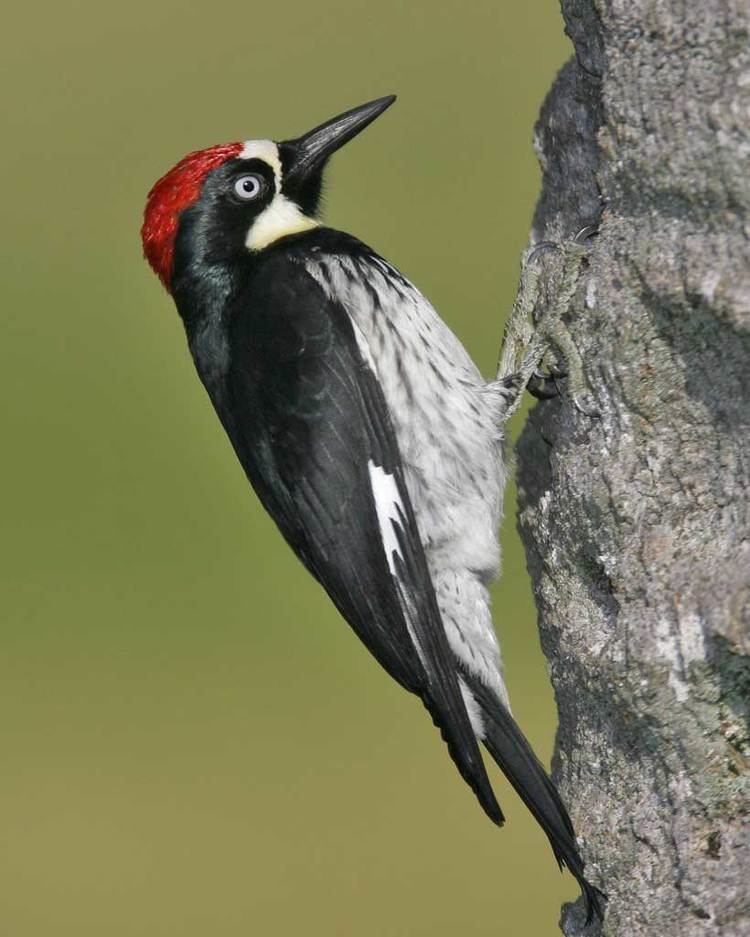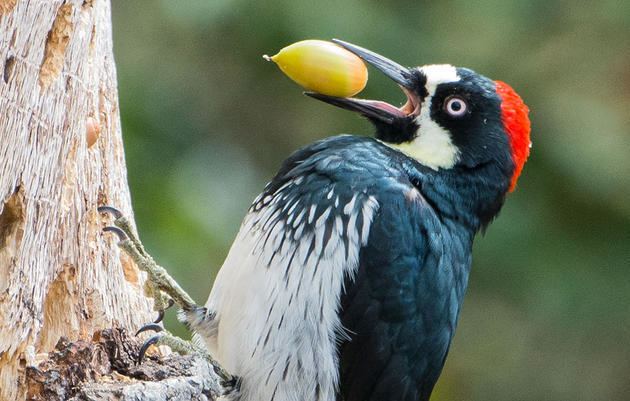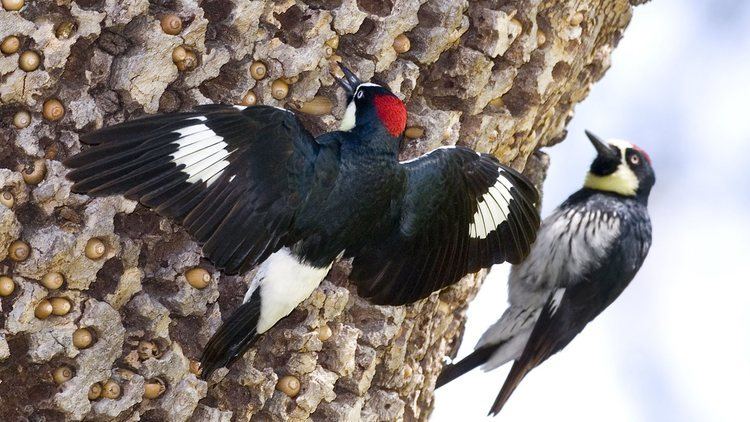Kingdom Animalia Order Piciformes Genus Melanerpes Rank Species | Phylum Chordata Family Picidae Scientific name Melanerpes formicivorus Higher classification Melanerpes | |
 | ||
Similar Bird, Woodpecker, Melanerpes, Sapsucker, Lewis's woodpecker | ||
Through the lens acorn woodpecker
The acorn woodpecker (Melanerpes formicivorus) is a medium-sized woodpecker, 21 cm (8.3 in) long, with an average weight of 85 g (3.0 oz).
Contents
- Through the lens acorn woodpecker
- Acorn woodpecker
- Description
- Breeding communities
- Food and homes
- Defense and storing
- Breeding behavior
- Threats and degradation
- Popular culture
- References

Acorn woodpecker
Description

The adult acorn woodpecker has a brownish-black head, back, wings and tail, white forehead, throat, belly and rump. The eyes are white. There is a small part on the small of their backs where there are some green feathers. The adult male has a red cap starting at the forehead, whereas females have a black area between the forehead and the cap. The white neck, throat, and forehead patches are distinctive identifiers. When flying, they take a few flaps of their wings and drop a foot or so. White circles on their wings are visible when in flight. Acorn woodpeckers have a call that is almost like they are laughing.
Breeding communities

The breeding habitat is forested areas with oaks in the hills of coastal areas and foothills of California and the southwestern United States south to Colombia. This species may occur at low elevations in the north of its range, but rarely below 1,000 m (3,300 ft) in Central America, and it breeds up to the timberline. The breeding pair excavate a nest in a large cavity in a dead tree or a dead part of a tree. A group of adults may participate in nesting activities: field studies have shown that breeding groups range from monogamous pairs to breeding collectives of seven males and three females, plus up to 10 nonbreeding helpers. Young from a single brood have been found with multiple paternity.
Food and homes

Acorn woodpeckers, as their name implies, depend heavily on acorns for food. In some parts of their range (e.g., California), the woodpeckers create granaries or "acorn trees" by drilling holes in dead trees, dead branches, telephone poles, and wooden buildings. The woodpeckers then collect acorns and find a hole that is just the right size for the acorn. As acorns dry out, they are moved to smaller holes and granary maintenance requires a significant amount of the bird's time. They also feed on insects, sap, and fruit.
Defense and storing

The acorns are visible, and the group defends the tree against potential cache robbers like Steller's jays and western scrub jays. Acorns are such an important resource to the California populations that acorn woodpeckers may nest in the fall to take advantage of the fall acorn crop, a rare behavior in birds. Acorn woodpeckers can also be seen sallying from tree limbs to catch insects, eating fruit and seeds, and drilling holes to drink sap. The acorn woodpecker will use any human-made structures to store acorns, drilling holes into fence posts, utility poles, buildings, and even automobile radiators. Occasionally the woodpecker will put acorns into places where it cannot get them out. Woodpeckers put 220 kg (490 lb) of acorns into a wooden water tank in Arizona. In parts of its range the acorn woodpecker does not construct a "granary tree", but instead stores acorns in natural holes and cracks in bark. If the stores are eaten, the woodpecker will move to another area, even going from Arizona to Mexico to spend the winter.
Breeding behavior
Acorn woodpeckers practice cooperative breeding, which is a relatively rare evolutionary trait that is thought to occur in only nine percent of bird species. Cooperative breeding is defined as more than two birds taking care of nestlings in the nest. With the acorn woodpecker, cooperative breeding occurs in two ways: coalitions and family groups. Coalitions of adult acorn woodpeckers nest together, localizing to storage granaries. Additionally, adult offspring often stay in their parents' nest and help raise the next generation of woodpeckers. It is generally believed that limited territories drive cooperative breeding behavior in birds, and in the case of the acorn woodpecker, this limited territory is the acorn storage granary.
As mentioned, adult acorn woodpeckers live together in "coalitions", which consist of up to seven co-breeding males and up to three joint-nesting females; however, most nests are made up of only three males and two females. Nesting groups can also contain up to ten offspring helpers. Interestingly, these breeding coalitions are typically closely related. The males are often brothers, and the females are usually sisters. Inbreeding is rare, however, meaning that co-breeders of the opposite sex are almost never related.
In groups with more than one breeding female, the females put their eggs into a single nest cavity. A female usually destroys any eggs in the nest before she starts to lay. Once all the females start to lay, they stop removing eggs.
Threats and degradation
Acorn woodpeckers, like many other species, are threatened by habitat loss and degradation. Competition for nest cavities by non-native species is an ongoing threat in urbanized areas. Conservation of this species is dependent on the maintenance of functional ecosystems that provide the full range of resources upon which the species depends. These include mature forests with oaks capable of producing large mast crops and places for the woodpeckers to nest, roost, and store mast. Residents are encouraged to preserve mature oak and pine-oak stands of trees and to provide dead limbs and snags for nesting, roosting, and granary sites to help preserve the acorn woodpecker's population.
Popular culture
Walter Lantz is believed to have patterned the call of his cartoon character Woody Woodpecker on that of the acorn woodpecker, while patterning his appearance on that of the pileated woodpecker which has a prominent crest.
